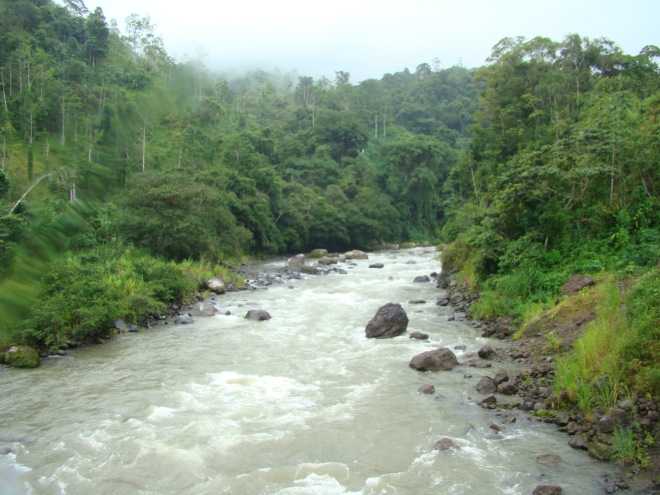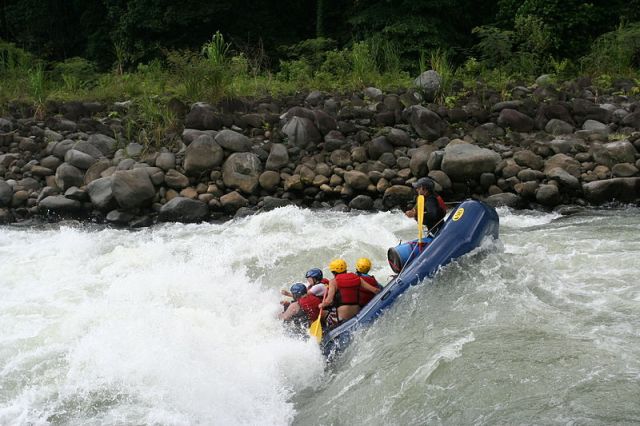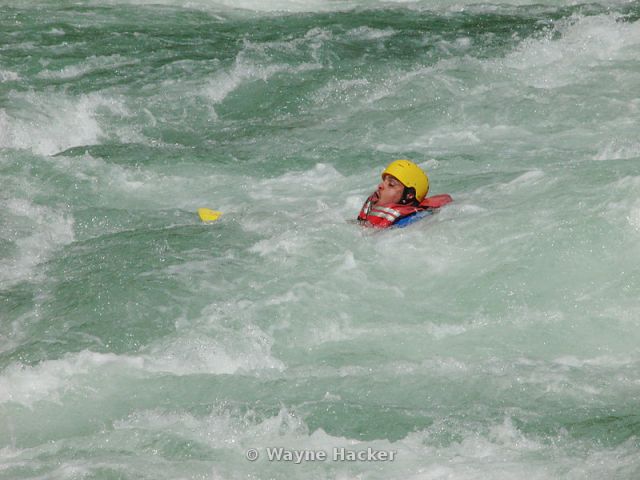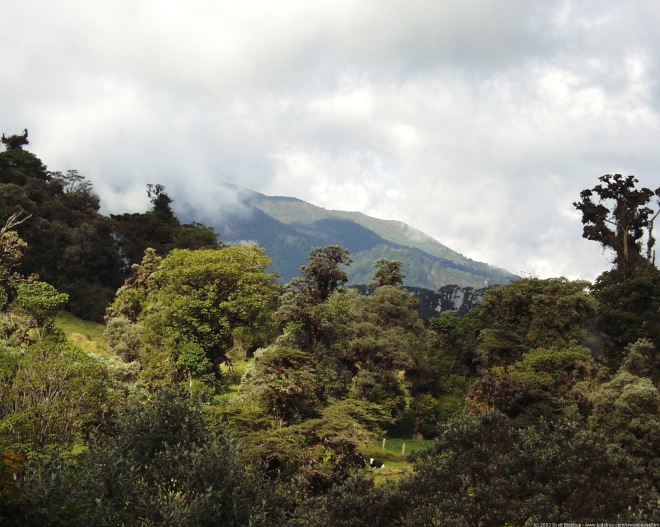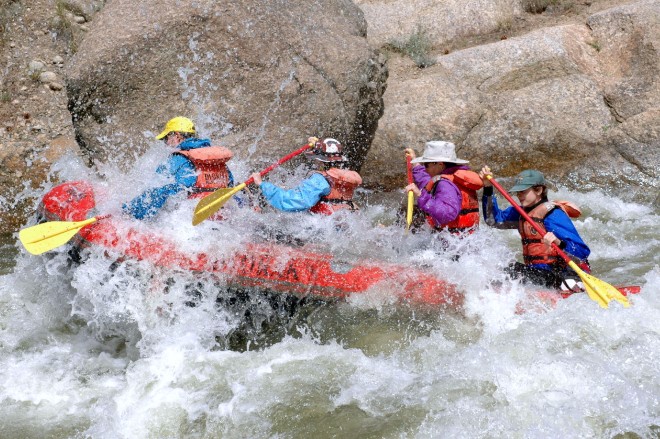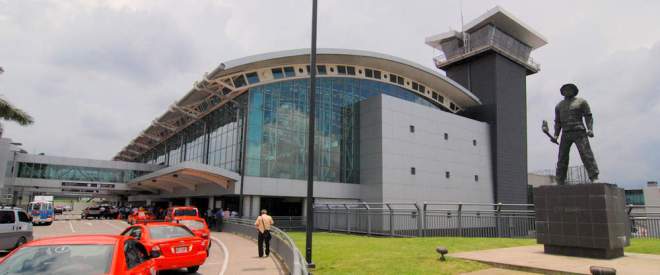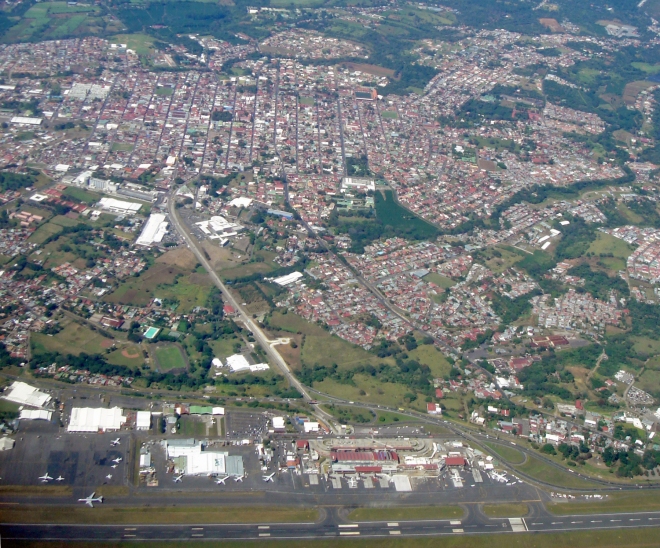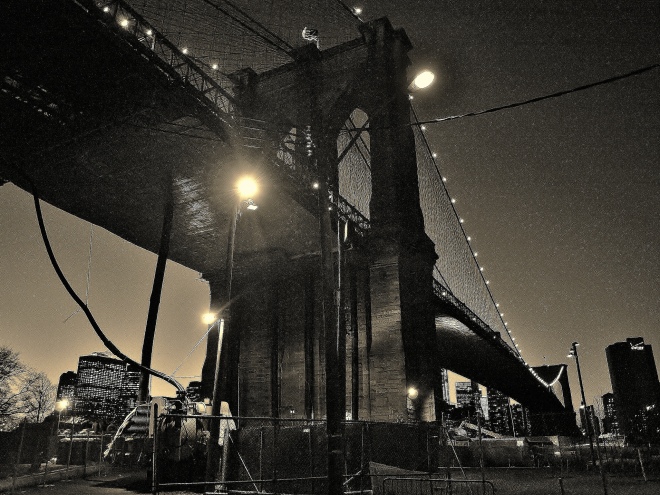A Trek through Costa Rica: Part IIIA: Turbulence in Turrialba
The slopes around Turrialba, Costa Rica (photo: bidstrup.com)
Our SUV has become stuck in mud on a narrow jungle road for the second time this morning.
A few hours before dawn – before we’ve trekked across the mountain village of Turrialba to the office of our rafting outfitter – a brief thunderstorm had sent sheets of heavy rain pouring onto the slopes of the mountains, reducing much of the earth to dribbling brown liquid.
As the guides work to free the back tires, we struggle groggily out of the truck to stretch our legs on a dry part of the road, snacking on Clif Bars and surveying the scene below.
To the south down the road lay the low shacks and bridges of Turrialba. To the west and about a thousand feet straight down from the ridge, the two main rivers tumbling out of Costa Rica’s central mountain ranges – the Rio Pacuare and the Rio Reventazon – crookedly intersect, wriggling like a couple of long lazy earthworms washed out of their burrows.
From these heights the rivers look motionless and two-dimensional as photos, shimmering through a haze of evaporating fog and mist, shot through with mottles of bright sunrise. It’s breathtaking. And slightly intimidating. After all, in a few minutes we are scheduled to be on one of those rivers – the Rio Pacuare, one of the top rafting rivers in the world – and headed into our first major Class IV rapid.
Finally the back tires spin free and we’re on our way again, bumping and roaring up and down steep jungle hills scattered with deciduous and banana and palm and the occasional wild coffee bush.
It doesn’t look like we’ll make our put-in time.
———————————-

The Rio Pacuare. (photo: livingincostaricatoday.com)
Finally at the put in, we unpack our gear as our main guide, a short and friendly Tico who looks no older than 18, explains the situation.
Normally, he explains, they would do a test-run in calm water so that inexperienced rafters can practice pulling others back into the boat, and the ones being pulled in can get used to being in the water. Also in normal circumstances we’d all practice floating a small section of rapids in only our life jackets.
But it’s late – we’re behind, there are several other groups behind us, so the guide skips all this. Instead they just show us how to stay in the boat (by jamming our river sandals under the seat in the center), tell us to paddle like hell and “avoid the big holes”, and throw us in.
You can probably guess this is a bad idea. With the exception of my then-girlfriend, we’ve all rafted before. But our experience has been limited to predictable rapids in high desert rivers of no more than Class II or at most Class III, with few swells and no huge holes or obstacles in our way. This river….well, let’s just say this river is an entirely different beast. An angry, homicidal beast.
There’s a period of calm as we launch out in the shallows from the pebbled banks. The guide, perched at the rear with the steering paddle, goes over our upcoming route. We’ll be covering 18 miles of the Pacuare, with one break in between for lunch. Safety kayakers will be stationed to the aft and to the rear of us as we go.
This all sounds reasonable, reassuring. Less so when, seconds later, we’re shooting down the river toward our first Class III (made a Class IV by the rainstorm and the rise in river level), and I’m barely able to remain seated atop the side. It feels like I’ll be launched into the river at any moment.
We bang on easily through the first Class III even while straining to discern the guide’s shouted commands from the rear. After catching our breaths, we look around at each other. Jungle birds shriek and chitter above us, invisible in the dense foliage drooping down from the canyon walls.
Is it supposed to feel this precarious? Why can’t I get a solid perch on this side? Should it be necessary to correct my balance every two seconds to stay upright even in calm water? Should I have bought rafting sandals in my own size, rather than borrowing my stepdad’s, which are much too large and already slipping off my feet? Am I just being a paranoid noob?
Then – BAM! A giant wave rears up bronco-like directly in front of us, towering over the stern of the boat, and the time for thinking is over. We plow directly into it.
We are aloft for a split, terrifying second, disconnected from the river, from the raft even – I see the bodies of my companions beginning to float helplessly up from their sides as if gravity had become unbolted – and then we slam back down into the water at an indescribable angle, so violently that the whole front of the raft folds like a check mark. My neck pops and the teeth of my upper jaw crush against my mandible.
The rear of the raft pops out backward as it straightens itself out, flinging the guide’s body aftward. How his back is not broken after this little flight I still don’t know.
This is like us, but with way more time IN the boat (photo: Wikipedia)
We have no time to catch our breaths or even to feel elated. A giant hole looms ahead. I blink, can’t quite believe what the visual information indicates, blink again. The river level drops at least 10 feet in directly in front of us. A long, flat ledge of rock marks the edge of the hole, and we’re only a few seconds away. Too close to do anything but hold on and plunge into it.
All higher thought disappears from my mind. Cold terror consumes me as I paddle. The guide screams behind us, jamming his steering oar as deep behind him as he can without losing grip on it – “Paddle! Paddle! Left side! Left side!”
Abstractly I think – dude, aren’t you the one who is supposed to be calm and keeping us together? He is clearly losing it.
We paddle as instructed. The edge draws nearer like an executioner’s blade. It’s like fighting a bear, pulling against this current. But we slowly coax the raft to our right. We’re clearing it! We’re clearing it! I think wildly.
But relief is short-lived. In our haste, we’ve over-corrected and don’t have time to get straight. The back end sweeps around almost 180 degrees. The stern catches the flat edge of the rock.
TO BE CONTINUED
A Trek through Costa Rica: Part II: A Day and a Night at Rudolfo’s (1)
Costa Rica: Part II: A Night at Rudolfo’s.
We four travelers stumble through the departure gate and into the ramshackle customs area of the Juan Santamaria International Airport. This airport is located in the San Jose suburb of Alajuela, a likewise ramshackle collection of low white houses and white stone streets that snake up into the green hills.
Alajuela (Image courtesy of ds-lands.com)
Chaos reigns in the customs queue, which stretches back almost to the gates and which random people weave through as if it were a chorus line. The world blurs by in flashes. I realize I left my consciousness back in the plane cabin.
Wearily we take out our declarations for the inspectors to view. How long will this take so that we can sleep? Will they mind if I nap while they rifle through our underwear? That conveyer belt looks comfortable enough. And so on.
Suddenly over the cacophony I hear a voice clear as a bell: “Christofer!” Which is my little brother’s name.
A burly middle-aged man past customs waves a sign and gestures for us to come right through. It turns out, this is our man on the inside. He is Rudolfo, a friend of a friend of my mother’s church group – shadowy Catholic connections best not investigated too thoroughly – who works as a customs inspector at this airport. He’s arranged to whisk us through customs and provide us a place to sleep that night at his house in Alajuela. I’ve never met him before and have no idea who he or his family are. But in travel you have to roll with things.
We hurry our ridiculous big-ass bags past the people in line, shaking our heads slightly toward them – the poor saps! Guess they don’t have an “inside man”. And then we burst out the big glass double doors and into the bright humidity of the pickup area, where Rudolfo’s best friend, Wile, is idling in a beat-up work van to pick us all up. \
Juan Santamaria International Airport (image courtesy of anywherecostarica.com)
Wile is a man of few words and a fast driver. Still, in my paltry Spanish I secure a few pieces of information. He and Rudolfo live right next door to each other on the same block and have raised their respective families essentially together. When we pull up in front of Rudolfo’s small bungalow, Wile jumps out and then opens his friend’s door with his own key.
We haul our packs into the dim house and dump everything on the floor. The couches beckon. Wile, correctly reasoning that the time zone shift will kill us unless we stay up and adjust to Costa Rica daylight, has other ideas. He’s gotten a wild hair to try on a role as a tour guide and drive us around his neighborhood, show us the sights.
These sights include an elementary school (“Escuela?” I ask as he points. “Escuela.” he confirms), a statue of some female saint in a park (captured by the sculptor in a degree of apparent torment) and a store. Compounding the scarcity of interesting features is our lack of serviceable Spanish with which to comprehend Wile’s thoughts about them.
Alajuela and suburban San Jose (image courtesy of Mario Valerio via Wikimedia Commons (c 2011)
Wile drives us back after he notices my brothers snoring away in the back seat. Finally, we’ll get some shut-eye.
This fantasy is soon snatched away. Rudolfo’s just gotten home. He’s gone through a lot of trouble, missed work, effort to host us here. It wouldn’t exactly be a grateful gesture to collapse on his couch for 12 hours, wake up at 3am starving and lumber around raiding his cupboards like a bunch of bears while his family tries to sleep.
He and his wife insist on making us some food – after all, here in their plane of existence, it is mid-afternoon. The fact that I and my companions currently occupy a separate, funhouse existence of hellish delirium escapes them. But I know they are just trying to be hospitable to their guests and ease us into the time change. So we sit at the table and try to make conversation while Rudolfo’s wife cooks a dish of rice and beans and some sort of meat.
The next thing I know we are fully immersed in what might be just a serious back and forth, but feels a hell of a lot like an argument. about where we are headed next.
Of course, when you’re exhausted and can’t understand 80% of what someone is trying to tell you, and you just need to go to the bathroom and sleep for 15 hours, it’s hard to distinguish between a disagreement and a spirited exchange.
I tell him of our plans to head East and visit Turrialba (for rafting), Limon (a West Indian seaport town) and Puerto Viejo on the Caribbean coast, he shakes his head adamantly. We should correct our course to the east coast , he says, and head south and west, as it is much nicer than Limon and there are plenty of places that turistas like to go.
Limon and much of the Caribbean side, he explains, is crawling with “negras” – black people of West Indian descent – who will beat us up, steal what we carry, and leave us for dead.
I am dismayed but not surprised at this argument, because I have heard that the mestizo Spanish class, which comprises most of the population, harbors much prejudice against the poorer islanders (the West Indians the Spanish themselves, of course, imported to work the banana plantations – a task they imagined themselves too high and mighty to stoop to.) Also, having grown up in a small agricultural town in rural Oregon with a 30% former Mexican migrant population, I’m used to hearing these generalizations.Still Rudolfo is our host and so I let the matter rest. Definitely, I tell him, we’ll go south and west.
Satisfied, Rudolfo steers the topic of our half-conversation to the glories of Costa Rican bananas – so much better than U.S. bananas, so ripe and sweet. I devour the one that he proffers to me, and damn if he isn’t right.
The foods that taste vastly superior in Costa Rica don’t stop at bananas, I will discover. The chicken here is crazy good – it has flavor and nuance you will never get from a U.S. store bird, because it’s mostly cooked still fresh from plucking, from birds that were strutting around in the restaurant’s back yard just hours before. The Coca Cola is more mellow and flavorful because Costa Rican bottlers use real sugar (not shitty corn syrup) delivered fresh from sugar plantations. And the black beans here – don’t even get me started on the wonders of Costa Rican frijoles negras. Hot damn.
And most importantly for a caffeine addict like myself, a cup of coffee that starts its week as dried beans on a table on an organic finca forty miles away – and has just been roasted yesterday – tastes vastly superior than coffee made from beans that spend months piled green on ocean freighters before being roasted in some factory 3000 miles away.
The rest of our couple of days with Rudolfo flies by. Wile’s high-school aged daughter regales us with tales of her friend’s rafting misadventures – a choice of anecdote that eerily foreshadows what is to come for us. Rudolfo’s nephew, an EMT in San Jose, stops by to offer us fresh goat cheese from his grandmother’s farm, which I try – and try immediately not to spit out. It’s warm and quivering, much like it just dropped out of the goat and into my mouth. But it’s a nice gesture.
And when it’s time to part, the whole family drives us into San Jose to drop us off at the hostel, the Dunn Inn,
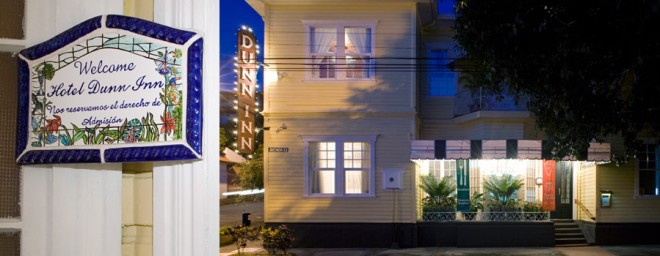
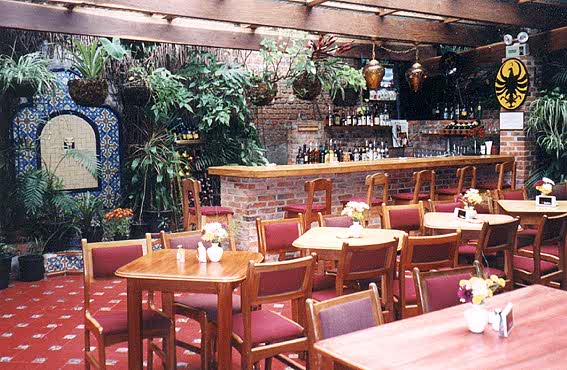 Hotel Dunn Inn, San Jose. Images courtesy of allcostaricatravel.com
Hotel Dunn Inn, San Jose. Images courtesy of allcostaricatravel.com
and they are genuinely sad to see us go, even though we did little more than scarf their food and drool snoring on their couch.
With the possible exception of Portugal, I’ve never experienced the level of hospitality displayed by our hosts in Costa Rica, wherever we go in the country. They are truly proud of their country and like to show it off to their guests. Lucky for us, because our adventures are just starting.
TO BE CONTINUED…
A Trek Through Costa Rica: Part I: The Flight
LEG ONE: FROM PORTLAND, OR TO SAN JOSE, COSTA RICA
—————————
Perry Farrell is on our plane from Portland to L.A.
In fact, we walk right alongside him and his two children and his very petite Asian wife all the way through the PDX International gate, and also the boarding tunnel (through which he carries his young, excitable child upon his shoulders while his wife carries a stroller) and into the plane, after which he and his brood settle into the first-class cabin and we are shuffled back to coach.
And then after we depart the plane in Los Angeles to await our connecting flight to Guatemala City, we can’t escape him. There he is in baggage claim next to us, horsing around and embracing his wife and chasing his kids and laughing the way one almost never does after an uneventful and surely routine flight. At which point my little brother Keifer (pretending he is taking a picture of my girlfriend) catches him on film, blurry in the background of his shot.
 Mr. Farrell (image courtesy of listal.com
Mr. Farrell (image courtesy of listal.com
This is very cool of course. He is a celebrity. And personally vindicating to poor Keifer, as right off the bat, this event almost justifies the added trouble of the extra forty or so pounds of lenses, tripods and film that he has lugged along on this ostensibly stripped-down, month-long trek of Costa Rica. But it doesn’t stop the rest of his travelling companions (myself, my girlfriend Stacky, and my brother Chris) from cruelly ribbing him about it.
—————————————-
Sometime during the following, interminable overnight flight from L.A. to Guatemala City and then to San Jose, a movie flickers into life on the monitors hanging above our seats. This movie is titled “Down with Love”, starring Ewan McGregor and Renee Zellweger.
Now, I cannot sleep on planes. Never have been able to. Maybe it’s just me, but something about having no control of whether I live or die – entrusting my life to a strange, exhausted pilot who is somehow maintaining 75 tons of airliner at an altitude of 35,000 feet above dark and jagged mountains – prevents me from drifting off into careless, baby-like slumber.
So, because it is the only activity to engage me in this dark tube of hurtling steel filled with lucky sleeping bastards, and because we have entered that peculiar suspension of time that occurs on long overnight flights and I need something with a definite running time to reassure me that this flight is progressing somehow, I watch Messr. McGregor’s “Down with Love”.
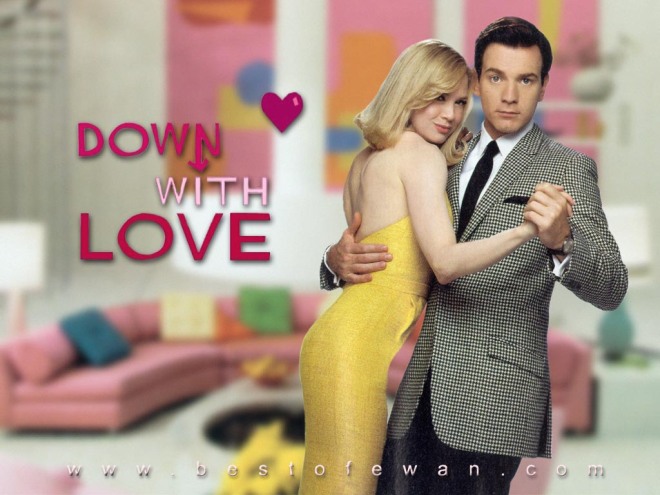 No. Down with THIS MOVIE. (image courtesy of fanpop.com)
No. Down with THIS MOVIE. (image courtesy of fanpop.com)
After the credits roll, I mentally recite a short list of activities available to me that would have been preferable to sitting through “Down With Love”. An abbreviated list follows:
1. Suffocating on the collected noxious emissions of the gastrically distressed fellow in front of me.
2. Punching a hole in the fuselage and being sucked out to free-fall gently into the Pacific.
3. You get the idea.
And I still cannot sleep.
——————————————-
Compared to the chaotic behemoth of L.A.X., the Guatemala City airport terminal, hunching low and blocky in the dim wilderness of 3 a.m Central America, looks like a poorly lit gas station that we’ve pulled up to on an overnight bus trip.
We’ve landed in Guatemala City in the dead of night to pick up a few passengers and to let a sick and feverish man off the plane. The man slumped to the floor around halfway through the flight and the crew have been propping him up ever since. Through the dark filter of my sleepless delirium, the ordeal of the two flight attendants assigned to escort the poor man off the plane seems grim. They strain epically to drag the bulky fellow out of the side exit and finally manage to stumble down the stairs to the tarmac below.
With that bit of unpleasantness done, the crew passes around immigration and customs forms for everyone to sign as if nothing has happened. Then we sit in the dark on the tarmac for what feels like hours before taking off again. All I can do is stare out the window at the gas station lights.
——————-
Sleep has not come by the time dawn sees us flying over the Nicoya Peninsula. We immediately begin our descent. We have finally crossed the massive Lake Nicaragua (which is more like a sea) and passed rather dramatically into Costa Rica.
Now, intensely green forested mountains rise to the left of us, rolling down to deep shadowed valleys and impenetrable tree cover, while to the right, the Pacific glistens vast and green blue with white misty shores. It is breathtaking.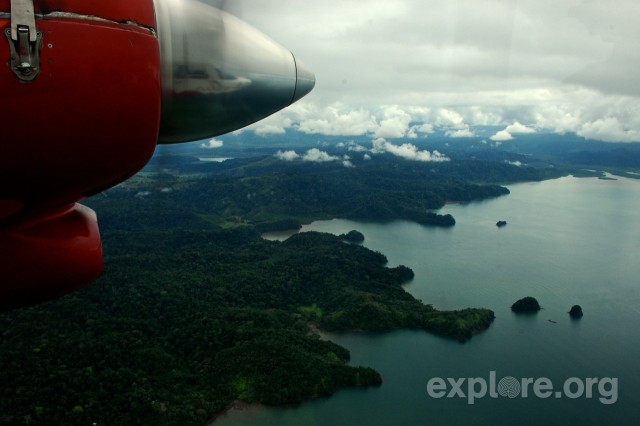 I’m immediately cheered. Soon, I will sleep a long and needed sleep (I cast my red eyes upon my brothers and my girlfriend slumbering just next to and behind me – lucky bastards!) and then, my rest taken, it will be off to romp around this giant playground.
I’m immediately cheered. Soon, I will sleep a long and needed sleep (I cast my red eyes upon my brothers and my girlfriend slumbering just next to and behind me – lucky bastards!) and then, my rest taken, it will be off to romp around this giant playground.
—TO BE CONTINUED–
Icebergs (Part I)
Icebergs (Part I)
1. Two Icebergs
Promises at dawn
Amount to nothing, at twilight.
She waits, she does
through sluggish afternoon, air conditioning
traffic crawling below
And worse,
Doom and Fate and Old:
the terror of
drying up before her time
It seems to her that always
he is spent by the day,
Programmed for the ground
Dashed, torn upon the curb
an accident victim
The accident of his Life
Just confounds him
She waits, she does.
But just so
Sound replaces light
Motion replaces reason
Lust replaces motivation
Frost replaces feeling
*****
2. The Frost
He is Sent out On an iceberg
Into the wide North Sea
No spear,
No fur
An expedition of one
In the towers
of the Trees
Crawling on bloody knees
he gathers the earth
in slabs of clay
Around his mud-streaked body
night falls
wind howls through corridors of fir
Snowladen and Black
A little further North
North seems right
*******
3. Suites
Credit goes to the crazy ones
Checking in, Checking out
Of their private hotel suites
She is one of those now
From the plastic pink deck chair
from the hotel’s penthouse
suddenly she knows the shape of this skyline
They all slide back, the details
like a row of dusty books removed from a shelf
then shoved back in all at once
A suite of Useless memories
that may as well be lies
His bed was over here, And over here the closet
Where above the suits and ties,
sat old primary school shoes
And a flimsy diorama he had made as a child, of the solar system
Often she stared at the diorama in the early morning beside him
And wondered how they two had happened to collide
in all the billions of miles of Space.
She couldn’t say now if in that whole of that solar system
he still existed anywhere
The solar system of faded crepe paper and cardboard
smeared with Elmer’s paste
Yellowed, decade-hardened;
She wonders where it is
She wishes she had kept it.
Pleiades, The Bear
Pleiades. The Bear.
Photo: (c) astronomer Hakon Dahle. Oslo, Norway
we lay
on our backs
in the night fields
in the sweet grass
And spied on the Pleiades. The Bear.
And of course broad Orion
in the Southernmost sky
Arm straight,
Leg back, tense.
Pulling taut the sprawling starry fabric of the Almost-dawn
With the steady draw of his single bowstring
Once also there was a shower of stars
that fell silently
over the mint fields
And the grass seed fields
Far Across,
the purple streaked beginnings of our Dawn.
But summer rolled suddenly to her side
Pulling the comforter with her
And in the haste of her departing
kicked up a Deadening
Dust
hiding Me from You
And so you would travel
Alone your long hidden way
to the northern cities
And I would wander the midnight country
After a kind of a Ghost
of what
Was
Chris10Eyck – “Fixin’ To Die” (cover of Bukka White)
Greeschlyn Can’t Fail
words and photography (c) 2013 by Benjamin J Spencer
When will you move?
A new town is called for.
You have your neat grass,
Your dew drops (you reason).
Then again you also have your stinging flies
And your defeated people
who look into empty, empty
shop windows,
Rubbing their hands together.
this is why You must move to Greeschlyn.
Greeschlyn cannot fail.
Why?
Greeschlyn has the most artfully glass-strewn of warehouses.
Greeschlyn’s water is pure lysergic acid.
Greeschlyn is glazed with two centuries of baker’s flour and petroleum
Greeschlyn’s young are clinically insane
(And They find this instructive)
In Greeschlyn, you can fish for starlight in cold, salty puddles
And eat moonlight cake with shy pledge-drive orphan kids
Greeschlyn
You see
Possesses those things that can strum your nerves like a lyre
And peel the skirt right off your pelvis
Momentous things
Glinting things.
Reboot – Two Months on the Road
Hey all,
I’m rebooting this blog as a mostly-travel blog – although I will still post articles and creative writing pieces/poems, of course, while on the road. Let’s just say that recently, it looks as if a major, long term travel-related project is in my imminent future (more on this later).
Now for those visitors to my blog who have paid attention, you have realized that I haven’t posted regularly lately. Actually this would be generous. I have stopped and started and sputtered and roared and then, horribly, coughed to a dead stop like a cheap, pathetic old V-8. Let me assure you, this situation shall be remedied shortly.
Until the details are ironed out and I know a bit more about what the path ahead will entail for me (and my partner in crime and in life (gypsytrampthief.wordpress.com) – I’ll be posting some of my favorite travel writing I’ve done over the years. Hope you enjoy, and thanks for sticking with this blog even with my prolonged absence from its pages.
To officially kick off this new chapter in the evolving story of this persnickety beast of a blog, here is a video covering the nearly two consecutive months of solid travel I notched up a couple of summers ago (June 1- July 20th, 2011). all around this beautiful U.S. of A
It was a long and rambling backpack from NYC to Bonnaroo Music Festival in Tennessee to San Diego, CA, to Yosemite Valley, and finally to the Oregon Coast, the Oregon Cascades and Willamette Valley. Pictures are by my brother, Chris Ten Eyck of San Diego, CA, and myself, BeejMcKay of New York, NY.

